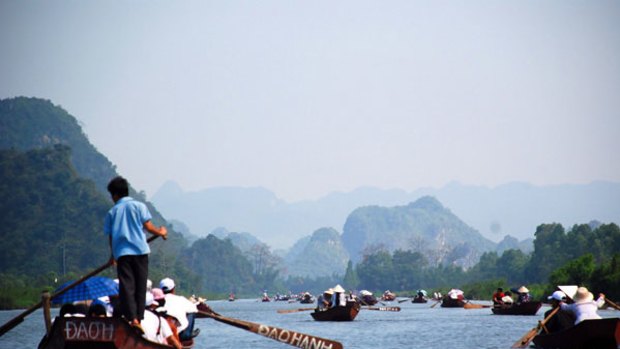
Ready to rock ... a parade of boats on the Yen River.Credit: Marc Llewellyn
A procession of burgundy-robed pilgrims and their followers kneel on the ancient steps leading down towards the holiest cave in Vietnam before touching their foreheads to the cold, damp stone.
We watch them stand up again, take a few more steps, then repeat the process. "They're from the south," our guide says. "The majority of Vietnamese people are non-religious. They're communist. These monks will make us late for lunch."
The monks are here to celebrate the long Pagoda Festival, which starts in late January to mid-February each year, according to the lunar calendar. This year, the official festival starts on February 19 and ends on April 28, when up to 30,000 pilgrims a day are expected. Pilgrims dribble in throughout the year, though.
The festival centres on the Perfume Pagoda - a complex of Buddhist temples and shrines built into the tree-clad limestone mountains south-west of Hanoi. We have reached its centrepiece, the Huong Tich cave, which has the appearance of an open dragon's mouth.
It is as dark as dusk inside the cave. Incense fills the air. Excited pilgrims crowd around a large statue of Buddha made from green stone. Many come to get blessings from stalactites and stalagmites, which is hardly Buddhism.
Childless pilgrims seek fertility by stroking rock formations - one for a boy, the other for a girl. Some attempt to be blessed with health by leaping to catch water dripping from a stalactite.
Others rub formations that can supposedly bring silver, gold or happiness.
The experience is vividly South-East Asian and there are very few Westerners among the hundreds of thousands who come here each year. Getting here is definitely more than half the fun though.
After a two-hour drive from Hanoi, we find ourselves at a humid riverside strip of supply shops. Many flog shots of rice wine from bottles crammed with cobras, scorpions and geckos.
On the riverbank, stallholders sell small-denomination banknotes to be used as offerings at the various temples and altars or hire out conical hats to protect tourists from the sun.
At Ben Duc Harbour, hundreds of shallow metal longboats are clumped together, waiting to take pilgrims upstream on a tributary of the Yen River.
For some people, including famed poets from times gone by, the one-hour river trip is the best part of the experience.
Four of us comfortably fit into one boat. A local woman sits up the back, armed with her wooden oars. We are part of a strung-out parade of boats moving slowly and quietly above shallows bulging with riverweed.
We glide past rice paddies and flocks of domestic white ducks dabbling at the water's edge. Occasionally we come across lone fishermen using two long sticks attached to a battery to stun tiny fish with electricity.
Slowly we edge nearer to the mountains and the blissful part of our trip is almost over as we approach another busy harbour.
The landward side of this place is lined with more stalls catering to Vietnamese tastes. Hanging from hooks outside basic eateries are large skinned dogs, jungle cats, wild pigs and various forest creatures we don't recognise.
More tempting are bread rolls made into the shape of crabs and baked in on-site wood ovens. Pork sausages are a local delicacy, along with small turtles stored in bamboo baskets.
Soon we move away from the riverbank and head inland, climbing past temples and stores selling everything from vibrant red-and-gold religious decorations to root vegetables, small local apricots and bowls of giant moving bugs.
We could have walked for an hour or more up a hill bustling with sellers and pilgrims but because of the heat we opt for a cable car journey, which takes us high above the forest.
From the top station it's a short stroll to the start of the descending rock staircase with its 120 well-worn and heavily cracked steps that lead steeply down towards the mossy cave entrance.
All this walking and sightseeing has made us hungry, so when the staircase is clear of monks we slowly head back towards one of the larger restaurants. We forsake any dish that could be a pet or a wild animal and opt instead for boiled rice and some stir-fried water spinach.
The way back home is, in turns, as fascinating and idyllic as our earlier experience. And as we slowly drift down the river, conical hats perched on our heads, we all admit that it has been the best day we've ever had in Vietnam, despite the cultural culinary challenges.
The writer travelled as a guest of Vietnam Airlines.
TRIP NOTES
GETTING THERE
Vietnam Airlines flies four times a week from Sydney and Melbourne to Hanoi via Ho Chi Minh City. Phone 9283 1355, 1300 888 028, see vietnamairlines.com.
WHERE TO STAY
The InterContinental Hanoi Westlake is an oasis of calm in Vietnam's teeming capital city. Rooms from about $140 a night. See ichotelsgroup.com.
WHERE TO EAT
The Aussie-owned Kangaroo Cafe runs small-group tours of Vietnam and offers good burgers and beers in a no-frills eatery. See kangaroocafe.com.
Sign up for the Traveller Deals newsletter
Get exclusive travel deals delivered straight to your inbox. Sign up now.